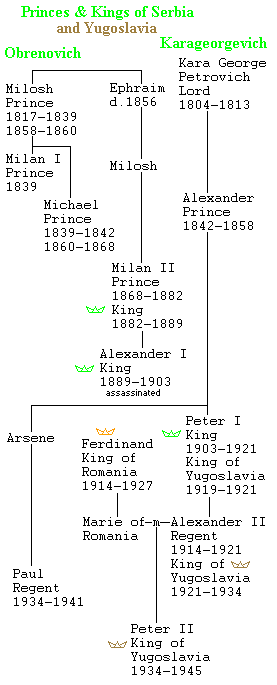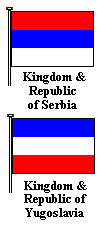|
Up
| |
Serbia
| 4. SERBIA & YUGOSLAVIA |
|---|
George Petrovic,
Kara ("Black") George |
leads revolt,
1804-1813 |
| Milos Obrenovic |
leads revolt,
1815-1817;
Prince,
1817-1839,
1858-1860 |
| Milan I |
1839 |
| Michael |
1839-1842,
1860-1868 |
Alexander Karadjordjevic
(Karageorgevich) |
1842-1858 |
| Milan II Obrenovic |
1868-1882 |
King,
1882-1889 |
| Alexander I |
1889-1903,
murdered |
Peter I
Karadjordjevic |
1903-1921 |
King of Yugoslavia,
1919-1921 |
| Alexander II |
Regent,
1918-1921 |
| 1921-1934 |
| Peter II |
1934-1945 |
| Paul |
Regent,
1934-1941 |
|
German & Italian Occupation, 1941-1943 |
|---|
|
German Occupation, 1943-1945 |
|---|
|
Communist takeover, 1945 |
|---|
| Ivan Ribar |
1945-1953 |
| Josip Broz Tito |
1953-1980 |
| Lazar Kolisevski |
1980 |
| Cvijetin Mijatovic |
1980-1981 |
| Sergej Kraiger |
1981-1982 |
| Petar Stambolic |
1982-1983 |
| Mika Spiljak |
1983-1984 |
| Veselin Ðuranovic |
1984-1985 |
| Radovan Vlaikovic |
1985-1986 |
| Sinan Hasani |
1986-1987 |
| Lazar Mojsov |
1987-1988 |
| Raif Dizdarevic |
1988-1989 |
| Janez Drnovsek |
1989-1990 |
| Borisav Jovic |
1990-1991 |
| Stjepan Mesic |
1991 |
| Branko Kostic |
1991 |
| Dobrica Cosic |
1992-1993 |
| Zoran Lilic |
1993-1997 |
| Srdjan Bozovic |
1997 |
| Slobodan Milosevic |
1997-2000 |
| Vojislav Kostunica |
2000-present |


In the shadow of the Napoleonic Wars and a Russian war with Turkey, Serbia began the Balkan independence movement against Turkey with a long revolt that led to an Ottoman grant of autonomy. The rivalry of the two leaders of the revolt, Milosh Obrenovic and "Black" George
Petrovic, however, led to a century of sometimes bloodly conflict between their two families, culminating in a coup in 1903 when King Alexander I was murdered. The Congress of Vienna in 1878 granted Serbia full independence, and the status of a Kingdom followed shortly. The Serbian dream was not just to unite all Serbian speakers remaining in Bosnia, Montenegro, Hungary, and Turkey, but all of the "Southern Slavs," including the Croatians, Slovenians, and perhaps even Bulgarians. In the aftermath of World War I, which began with the Serbian inspired assassination of the Archduke Francis Ferdinand of Austria in Sarajevo, this dream was realized in the establishment of Yugoslavia, which contained all the Southern Slavs except for Bulgaria, which had its own fiercely separate traditions and ambitions. Macedonia, however, had been wrested from Bulgaria in the Second Balkan War (1913). These benefits were substantially due to the Russians, to whom the Serbs looked as the protectors and patrons of the Orthodox Slavs. World War I formally began when Russia declared war on Austria to protect the Serbs. The flags of both Serbia and Yugoslavia are like the tricolor flag of Russia, with just a different arrangement of the stripes.
 The ethnic tensions between Orthodox Serbs and Catholic Slovenes and Croatians (and others), however, manifested themselves both in World War II, when the Germans found willing allies in the Croatians, and with the Fall of Communism, when the growth of democracy unmasked the separatist hostilities again. Yugoslavia broke up, with bitter fighting, atrocities, and "ethnic cleansing" as the various communities and new states sought to secure territory. The ethnic tensions between Orthodox Serbs and Catholic Slovenes and Croatians (and others), however, manifested themselves both in World War II, when the Germans found willing allies in the Croatians, and with the Fall of Communism, when the growth of democracy unmasked the separatist hostilities again. Yugoslavia broke up, with bitter fighting, atrocities, and "ethnic cleansing" as the various communities and new states sought to secure territory.
Former Yugoslav
Republics |
|---|
| Slovenia |
| Croatia |
| Bosnia Herzegovina |
| Macedonia |
Although all the groups have been guilty of offenses, the consenus of international observers and investigators, not to mention the War Crimes Tribunal in the Hague, seems to be that the Serbs, seeking to maintain a dominant position and initially with a military advantage, are more guilty than others, especially in Bosnia and Kosovo. The future remains uncertain, as NATO/UN peacekeeping forces are the only thing that seems to restrain the violence from breaking out again in Bosnia, and the status of Kosovo is open, as Serbs flee the retaliation of the Albanians, which has extended to vandalizing churches and monasteries, and the Albanians have no interest in being returned to Serbia. All the now stands between "Yugoslavia" being just Serbia is the continued adherence of Montenegro. The two countries are no different ethnically, linguistically, or religiously. All that is different is history, which is enough to fuel a Montenegran independence movement. Be that as it may, the combined state has essentially become Serbia again.

The Balkan Wars all but eliminated Turkey in Europe. In the First War (1912-1913), everyone attacked Turkey, which even lost Adrianople to Bulgaria. Serbia was going to annex Albania, but the Great Powers required that it become an independent state. The Serbs were not happy about that, and Bulgaria wasn't happy about its share either. So the Second War (1913) featured everyone against Bulgaria, which lost Macedonia to Serbia, Adrianople to Turkey, and some territory south of the Danube to România. Meanwhile, Italy had been at war with Turkey in 1912 and had obtained Libya and, on this map, the Dodecanese Islands.
| |
Turkey
Turquie
Türkei
Turkije
Türkiye
|





